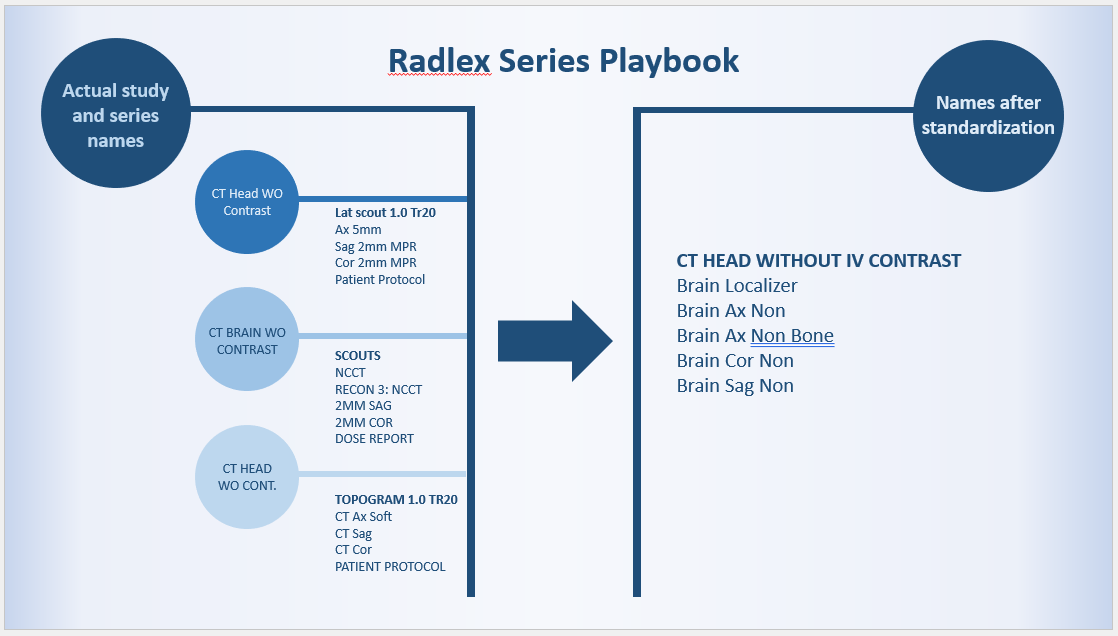RadLex Playbook Series
DICOM imaging studies frequently include multiple image series, each acquired using a distinct protocol (e.g., view, phase, contrast). These series are described in widely varying ways by different device manufacturers and sites, which raises a number of issues in the implementation of hanging protocols, clinical and business operations in radiology and aggregation and analysis of imaging data.
Building on the success of the Playbook project, the RadLex Committee has initiated work to address these issues and have assembled a task force of radiologists and informaticists to develop a set of standardized, vendor neutral, imaging-series names.
The committee includes members from academic and private practice as well as industry.
Jacob Bernhard, Sectra
Beverly Collins, PhD; Penn Medicine
Trafton Drew, PhD; Sirona Medical
Ross W. Filice, MD; MedStar Georgetown
Rodney Hawkins, Agfa
Jason M. Hostetter, MD; Wellspan Health
R. Kent Hutson, MD; Rad Partners
Martin Huber, Siemens
Gloria L. Hwang, MD; Stanford University
Charles E. Khan, MD, MS; Penn Medicine
Marc D. Kohli, MD; UCSF
Nina Kottler, MD, MS; Rad Partners
Jeff Lerman, PhD; Sirona Medical
Andrei Leontiev, Visage Imaging
Chelsey Lewis, GE HealthCare
Jeroen Medema, Philips
John Mongan, MD, PhD; UCSF
Joel Morehouse, RT; University of Michigan
Steven Nichols, GE HealthCare
Michael Ohliger, MD; UCSF
Stacy O’Connor, MD; University of Rochester
Steve Rankin, Enlitic
Babak Saboury, MD, MPH; United Theranostics
George L. Shih, MD, MS; Weill Cornell Medical
Scott Stanton, Enlitic
Timothy P. Szczykutowicz, PhD; University of Wisconsin, Madison
Kenneth C. Wang, MD, PhD; University of Maryland School of Medicine
Paige Ward, Agfa
Greg Zaharchuk, MD, PhD; Stanford; Subtle Medical
RadLex Playbook Standard Series Names

Proposed CT series naming convention
The Study Series Standardization Task Force created an interactive tool for the public to test and provide feedback for the proposed CT convention. Enter your institution’s series data and watch the suggested series name appear.
Test the RadLex Playbook Series
Laterality
Body Part
Body Part Modifier
Maneuvers
Anatomic Plane
IV Contrast
Luminal Contrast
Series Type
Series Type Modifier
Spectral Energy
Slice Thickness
Kernel
View
Repeat #
Share your feedback with us
After you test the RadLex Playbook Series, be sure to share your thoughts with us. Your feedback is valuable and will guide product improvements.
Convention philosophy
- Vendor neutral
- Applicable across practice settings
- Applicable across subspecialties
- Provides clinically useful information that would inform the radiologist which series to select
- Includes body part up front, to assist with identifying series for multi-body part acquisitions
- Data that is not necessary for series selection and that can be found within the DICOM is not necessary to include
- To focus on the most common and clinically useful series name elements—with the understanding that it is not possible to be all inclusive while remaining non-prescriptive of exam protocols
Convention goals
To provide a standardized format for the most common series-name elements to achieve consistency of data across scanners and institutions allowing for hanging protocols to function reliably.
Secondary gain of series naming convention
- Standard series data elements will facilitate research efforts
- Standard series data elements will facilitate algorithm development, training, testing and utilization
Initial convention scope
The proposed series naming convention was developed with CT in mind, as this modality is widely available, allowing for diverse application, testing and feedback.
The next phase of the series standardization project is to collaborate with our industry partners to expand the naming convention for MRI series application.
Contact us
For questions, please email informatics@rsna.org.
FAQs
- Recon: < 1 mm
- Thin: >= 1 mm and < 2.5 mm
- Std: >= 2.5 mm and < 5 mm
- Thick: >= 5 mm
- All series descriptions will use Title Case
- Space is the only allowed separator between series description elements; underscore is the only allowed separator within elements